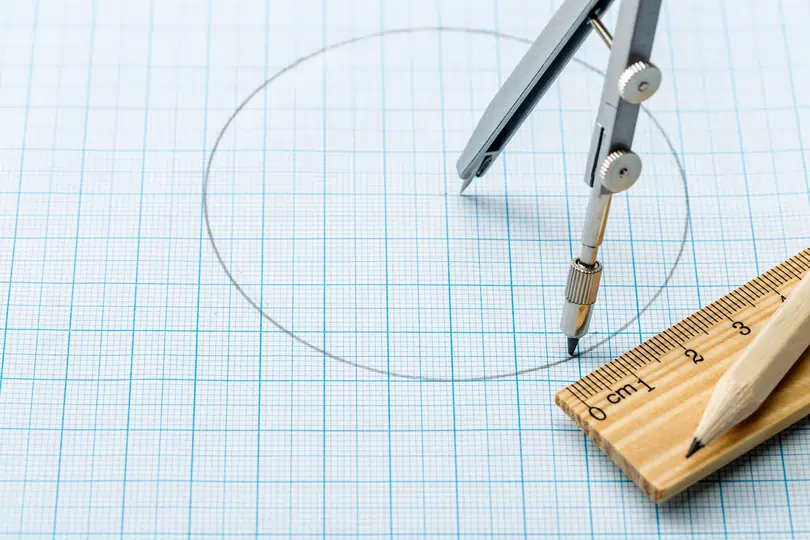A brief history of geometrical shapes

While you may be familiar with the history of Greek maths geek and philosopher Pythagoras and his famous theorem, have you ever wondered where shapes like the rhombus, trapezium, triangle, parallelogram, and kite come from?
Just like the Pythagoras theorem, these shapes have played an important role in shaping (pun intended) the field of mathematics, engineering, and art across civilisations and cultures around the world.
So, let’s travel back in time to the ancient Greeks and Egyptians and take a closer look, shall we?
Buckle up!
Rhombus

The rhombus is a four-sided shape with all sides of equal length and is one of the oldest known shapes in mathematics. While some say it originated in the early 16th century during the Renaissance period, many believe it first appeared in Babylonian clay tablets.
Primarily used as decorative ornaments, the symbol soon became an important symbol of prosperity, balance, and harmony found on artifacts from many cultures including Ancient Egypt, Greece, Rome, China, and India.
Over the centuries, the rhombus’ popularity grew with the development of mathematics as a tool for measuring distances on maps and constructing perfect circles. Its four equal sides also made it a great shape for creating patterns and tessellations.
Today, it is still found in many areas of architecture, design, and art. It’s also applied to computer algorithms, game theory, quantum mechanics, nanotechnology, and various engineering fields where its symmetrical qualities are especially useful.
Trapezium

The trapezoid, or trapezium as it's known in some countries, is a four-sided geometric figure with origins dating back to Ancient Greece. Its name derives from the ancient Greek word 'trapezion', which means 'a little table'. That’s because the shape of the trapezium resembles a table with legs that aren’t parallel to each other.
In the field of mathematics, the trapezium is commonly used for measuring angles and lengths on paper, in particular the calculation of the area and perimeter of irregular shapes.
That’s not all. Throughout history, the trapezium has been a prominent feature of many artworks such as ancient Greek pottery, medieval tapestries, and many Renaissance paintings that used it to create symmetry and harmony.
Fast forward to modern times, the trapezium continues to inspire sculptures, abstract paintings, and street art. It can also be seen in architecture with its use in famous buildings such as the Louvre Museum and the Sydney Opera House.
Triangle

The triangle is one of the earliest known geometric shapes, with evidence of its use dating back to ancient Mesopotamia (modern-day Iraq), over 5000 years ago. Its name was derived from the Latin word 'triangulus', meaning 'three-cornered'.
Throughout history, the triangle has been held up as a symbol of stability and strength, with many cultures associating it with the power of three gods or spiritual entities.
While civilisations like the Egyptians adopted the concept of the triangle in building their pyramids, it was the Greeks who further developed the concept of the triangle with Euclid's Elements, the famous Mathematics treatise that served as a foundation for mathematical education for centuries to come.
In modern times, the triangle is widely used in mathematics, engineering, and architecture. Apart from building stable structures, its properties allow for calculations ranging from simple trigonometry to complex equations such as those dealing with wave functions.
Parallelogram

The parallelogram is a geometric shape that has been studied and used throughout history. Its name comes from the Greek words 'para', meaning 'beside', and 'logos', meaning 'ratio'.
Its origin can be traced back to ancient civilizations such as the Egyptians, who used the shape in the construction of their buildings and pyramids due to the symmetry and stability that the parallelogram offered.
For that same reason, the interior of the arch of a modern-day bridge often takes the form of a parallelogram. Apart from its unique structural properties, it’s also found in many everyday objects such as tables, chairs, and bookshelves for aesthetic reasons.
Last but not least, parallelograms are used in computer graphics to represent three-dimensional objects.
Kite

The word 'Kite' originates from the Ancient Greek word 'δρακοῦς' (drakous), as is used to describe a type of bird. The origin of the kite remains a mystery. However, many believe it was first invented by Euclid of Alexandria during the 3rd century BC.
From there, Islamic scholars adopted and advanced kite geometry in their own mathematical studies. It was also used during the Renaissance period by mathematicians such as Leon Alberti, who built upon Euclid's original concept.
In the modern day, Kite geometry is used in cartography, architecture, and engineering. It can help model the shape of structures or map out coordinates to represent geographical locations. Additionally, kite geometry is often used in algebraic equations and geometric problems, helping visualize the relationships between different points in an equation


 SG
SG  VN
VN 


















